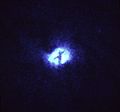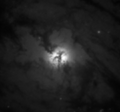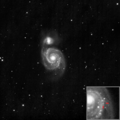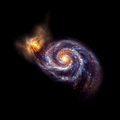Whirlpool galaxy facts for kids
Quick facts for kids Whirlpool galaxy |
|
|---|---|

|
|
| Observation data (J2000 epoch) | |
| Constellation | Canes Venatici |
| Right ascension | 13h 29m 52.7s |
| Declination | +47° 11′ 43″ |
| Redshift | 463 ± 3 km/s |
| Distance | 23 ± 4 Mly (7.1 ± 1.2 Mpc) |
| Type | SA(s)bc pec |
| Apparent dimensions (V) | 11′.2 × 6′.9 |
| Apparent magnitude (V) | 8.4 |
| Notable features | Interacting with NGC 5195 |
| Other designations | |
| Question Mark Galaxy, Rosse's Galaxy, M51a, NGC 5194, UGC 8493, PGC 47404, VV 001a, VV 403, Arp 85, GC 3572 | |
| See also: Galaxy, List of galaxies | |
The Whirlpool galaxy, is also known as Messier 51a, M51a, or NGC 5194. It is a large galaxy with well-defined spiral arms, with a smaller companion galaxy. They have been through a collision, and are still interacting.
The Whirlpool was the first galaxy to be classified as a spiral galaxy. Different methods put its distance as between 15 to 35 million light-years. Recently it was estimated to be 23 ± 4 million light-years from the Milky Way. Messier 51 is one of the best known galaxies in the sky.
Its spiral arms are so impressive and well-defined that it is called a "grand design" spiral galaxy. It has an active galactic nucleus, no doubt fuelled by a massive black hole.
The galaxy and its companion, NGC 5195, are easily seen by amateur astronomers, in the constellation Canes Venatici. The two galaxies can be seen with binoculars. The Whirlpool galaxy is also a popular target for professional astronomers. They study its galaxy structure (particularly the spiral arms) and galaxy interactions.
Images for kids
-
Sketch of M51 by Lord Rosse in 1845
-
Supernova impostor AT2019abn, imaged by the Hubble Space Telescope
See also
 In Spanish: Galaxia Remolino para niños
In Spanish: Galaxia Remolino para niños










